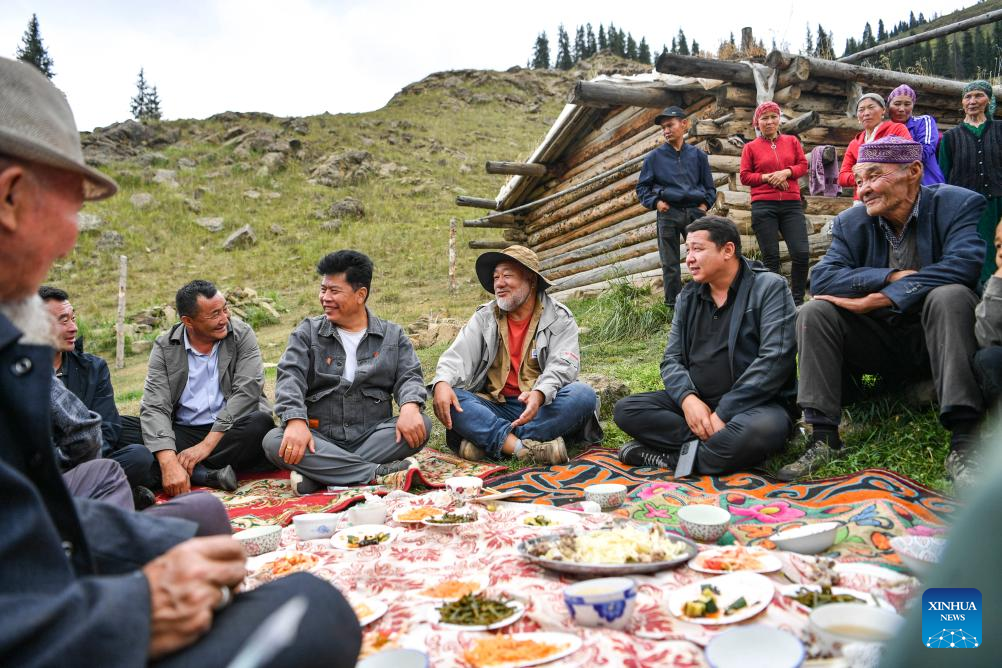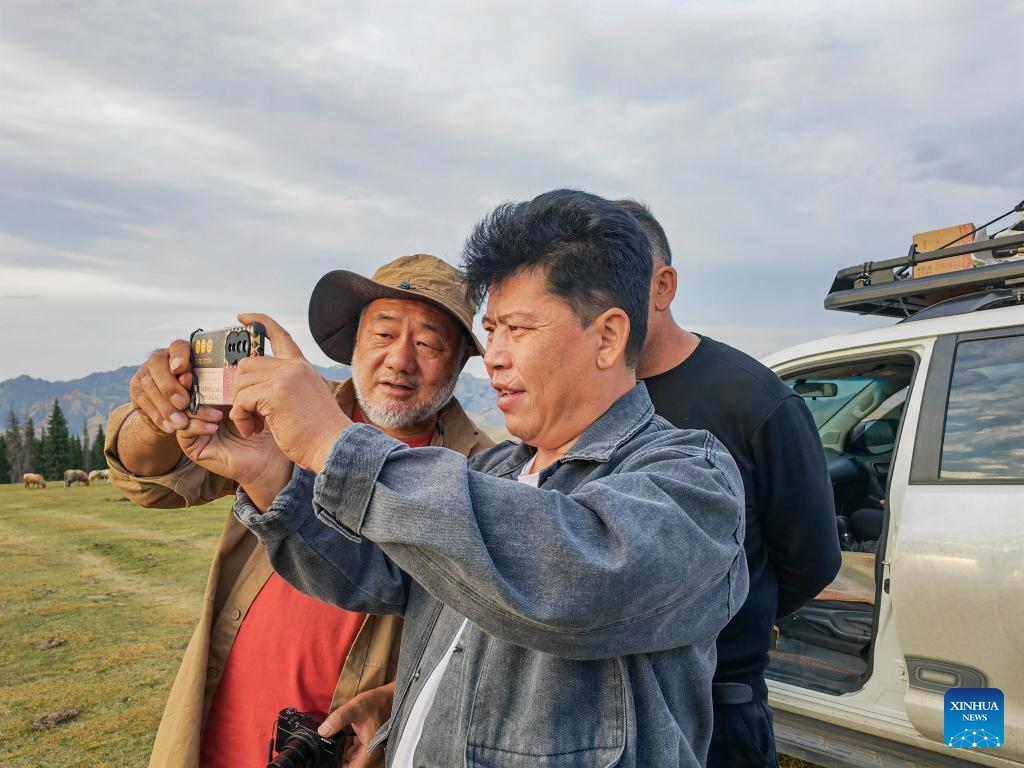
Tan Chengjun (C), a member of the Photojournalist Society of China, talks with herdsmen in the pastoral area of Solbastao in northwest China's Xinjiang Uygur Autonomous Region, Aug. 12, 2023. (Xinhua/Hu Huhu)
URUMQI, Sept. 18 (Xinhua) -- After a full day of riding horseback, Ahli Tudahen finally found a spot on the pasture with cell phone reception. Not wasting a single second, he hurried to post his latest works of art online -- a couple of photos.
Ahli lives in the vast pastoral area of Solbastao in Xinjiang Uygur Autonomous Region, northwest China. According to the local herdsman, the grazing grasslands are so secluded that even after reaching the end of the roads accessible by vehicles, one still needs to ride on horseback for two days. This quiet life, however, offers endless inspiration for Ahli and his some 70 fellow herdsmen in the "Wumot" photography team.
The word "Wumot" means "hope" in Kazakh. Since its establishment in 2018, the team has amassed a collection of over 10,000 photographs showcasing the exquisite pastoral landscapes and nomadic lifestyle. These images, which encapsulate the charm of cattle, sheep, and day-to-day life on the pasture, have mostly been captured with cell phones.
The passion for photography in Solbastao was ignited by a romantic event. In 2018, Tan Chengjun, a member of the Photojournalist Society of China, was invited to shoot wedding photos for Ahelitay, the son of a herdsman he was well acquainted with.
"Mr. Tan is a photographer!" The news spread quickly. As more and more herdsmen asked Tan to teach them how to shoot photos, the experienced photographer decided to form the "Wumot" team and took on the role of team supervisor.
"For the herdsman and me, photography adds happiness to our life," said Tan. "Life in the pastoral areas can sometimes be monotonous, but teaching herdsman to capture the beauty of their surroundings with their mobile phones can enhance their spiritual experiences."
Photographic terminology is difficult for these pastoral students to understand, so Tan tries to explain things in a more accessible manner -- "A well-composed photo is like a weighing scale. To keep the balance, you can't put heavy things on one side and light things on the other;" or, "try to add more colors in your photo. Just like wearing some make-up before you go out."
Instead of overwhelming pastoral students by pumping too many skills into their heads, Tan aims to foster a natural path of development. Although Huan Husayin has bought a camera and some other team members plan to buy a drone, most herdsman photographers shoot with their cell phones. The equipment they use might be simple, but the outcomes "have really blown my mind," said Tan.
Tan's favorite picture is Aray's "Horseback People," which was taken from behind the head of a horse facing the lush mountains in the distance.
"The horseback people are not seen in the picture, but it conveys Kazakh people's strong feelings towards the pastures, the horses and their nomad lifestyle," Tan commented.
Tan has also been impressed by the herdsmen's unique observations of their daily life -- a cow worriedly watching its calf crossing a river, a little girl enjoying her summer vacation sitting in a manger, and a lamb that has just been born, still shrouded with the placenta.
"Pressing the shutter is just as simple as shepherding," said a herdsman.
"These photos have a special pleasing quality about them, with a rich range of subjects. This is something that not even professional photographers can achieve," said Tan. "The magnificent mountains, the migration, and the bond between humans and animals... They are all very good subjects."
Tan hopes, with his guidance, herdsmen can better record their lives, cultivate a perception of beauty, and fully experience the great changes of their hometown. He is happy to see new subjects showing up in their pictures -- beekeeping becoming a new occupation for the Kazakh, the first college graduate joining the local women's federation, and a new recruit saluting his veteran father before he leaves home for the army.
With the support of the local government, the team has held three photography exhibitions. A group of four photos titled "Journey to the Alpine Pasture" granted Ahli the first prize in the first exhibition, and he was awarded an electric cooker. In the third exhibition held last year, Ahli displayed 200 photos and grabbed the first prize once again. This time, the reward was 1,000 yuan (138 U.S. dollars).
Tan paid a visit to Solbastao last month, but he did not see Ahli around. "Maybe he is grazing his sheep in the mountains," Ahli's neighbor told him. "Or maybe he is searching for signal somewhere. Who knows?" ■

This photo taken on Aug. 11, 2023 with a mobile phone shows Tan Chengjun (L), a member of the Photojournalist Society of China, teaching herdsmen to take photos with a mobile phone in the pastoral area of Solbastao in northwest China's Xinjiang Uygur Autonomous Region. (Xinhua/Hu Huhu)

This photo taken on Aug. 13, 2023 with a mobile phone shows Tan Chengjun (C), a member of the Photojournalist Society of China, explaining photos to herdsmen in the pastoral area of Solbastao in northwest China's Xinjiang Uygur Autonomous Region. (Xinhua/Hu Huhu)

This aerial photo taken on Aug. 16, 2023 shows a view of the pastoral area of Solbastao in northwest China's Xinjiang Uygur Autonomous Region. (Xinhua/Hu Huhu)



